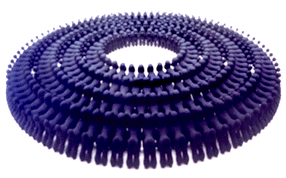Gaining not only American, but also European attention, Katharina Fritsch entered the realm of the art world and quickly established herself as a distinguished woman sculptor. Being one of the few prominent females in an arena that mainly showcased the talents of men; she boldly led her gender towards recognition in the area of recent Neo-pop art. Katharina was born in 1956 in Germany and began her studies there at the Kunstakademie.
Her work resembles that of Jeff Koons, and Andy Warhol in the fact that she often takes objects from popular culture and though replication and exploitation alters the contextual content of these items. This practice of taking objects from the social environment and manipulating their form can be seen as a result of Koons' "kitchy, souvenir art" influence.
Through color and content, Fritsch is able to transform these duplicated images into viable pieces of art. Her sculptures are modeled after items of popular culture. An example is an oversized, fluorescent yellow replica of the Madonna, one of her most famous sculptures. Its exhibition space is a small town's square, in a space wedged between a public warehouse and a church. Through its placement the sculpture acts as a juxtaposing monument, creating an irony of a visual form with its surroundings. Its form illustrates the harsh contradictions between the morals of the church and its color seemingly representing the rebellious actions of state society. On balance, it also serves as a link that binds the two contradicting worlds together.
From Warhol she borrows the principle of repetition. She often creates a large number of one particular sculpture, all the same in form and size. Through monotonous replication she is able to change the connotation that the object was originally meant to express.
Another characteristic fluent in Fritsch's work is her menacing portrayal of animals. In her famous sculpture, "The Rat King", Katharina sculpted a ring of rats. Each rat is eight feet tall, and perched on its hind legs. Facing outwards they cautiously raise their tiny front paws in suspicious guard. Inside their circle is a knotted configuration, made by the intertwining of each rat's tail. Legend has it that during particular seasons, groups of rats would congregate and through the connection of their tails, take on supernatural powers. Man's caution and fear of these creatures stems from their role as a vehicle in the spread of the bubonic plague, an epidemic which killed thousands of Europeans during the fourteenth century. The size of Fritsch's sculpture works to her advantage by providing the viewer with an unexpected shock in the form of a larger-than-life rat, an exaggeration of a creature that tends to frighten most individuals.
Building further on these same principles of uneasiness and suspicion, Katharina created "Man and Mouse". The sculpture is oversized and uncomfortably realistic, consisting of a man lying in bed on his back. Upon his stomach resides an equally large rat resting on his haunches, boldly staring the man directly in the face. The viewer cringes with uneasiness as once again they're confronted with frightful foreboding in regards to the rat's intentions, and therefore welfare of the man.

Not limiting herself to only varmints, Katharina evokes disturbance directed towards the dog, a creature usually considered man's best friend. This piece consists of life-sized black poodles encircling a white, human newborn. One's first reaction is initial alarm for the safety of the child.
Being left uninformed about the context of the events in the scene, the viewer shudders and approaches the piece with caution, almost in an attempt to avoid startling the figurine dogs and provoking a violent reaction. This nervous anxiety remains until the viewer once again returns to the realm of the natural world, comforted by the reminder that these hazardous perils exist only in fictional art and not in reality. Or do they?
Katharina Fritsch has earned her role in today's art world as a leading female sculptor. Through her talent of viewing situations with a unique, supernatural twist, she has brought to the forefront a new range of emotions for her audience to experience. Her work is shown in the United States at one of New York's most advanced art galleries, Matthew Marks, located in Chelsea. Two recent installations shown there in 2000, "Money Heart" and "Witches House with Mushroom and Four Balls" continue her interest in basing her work on myths and fairy tales.
Page author: J.S. & C.F.
